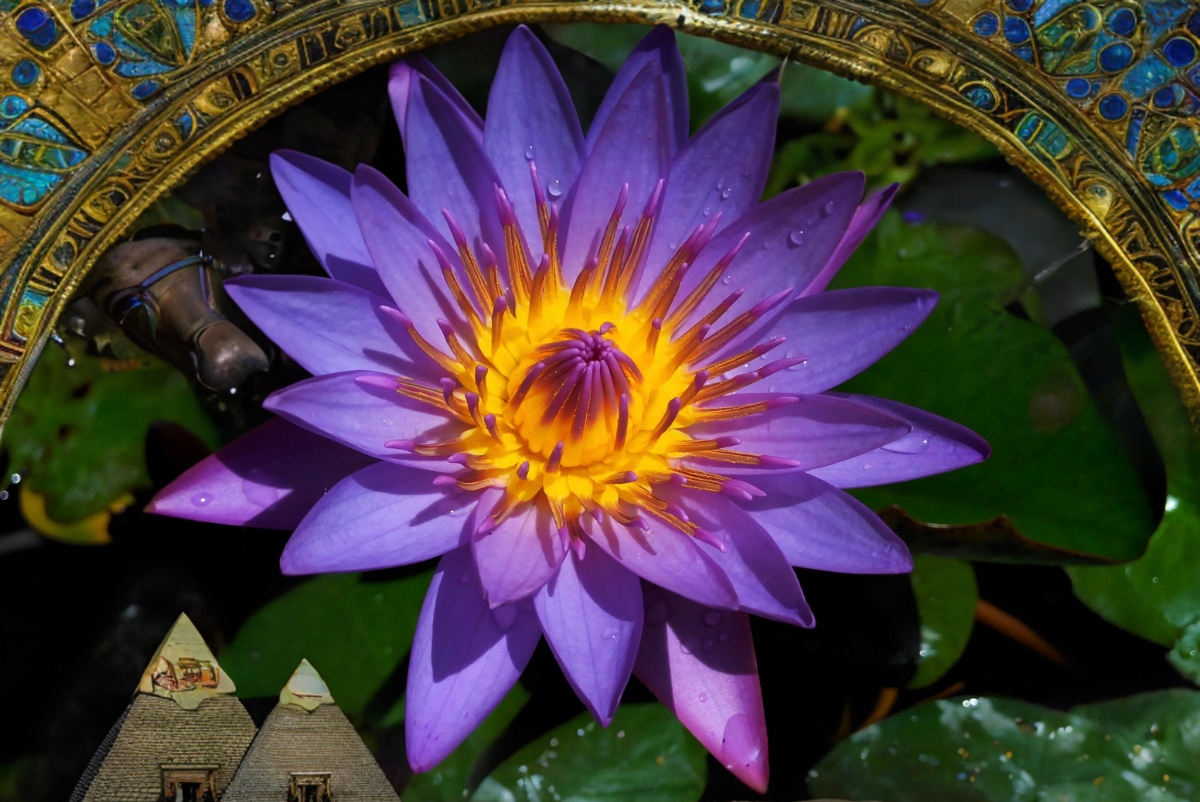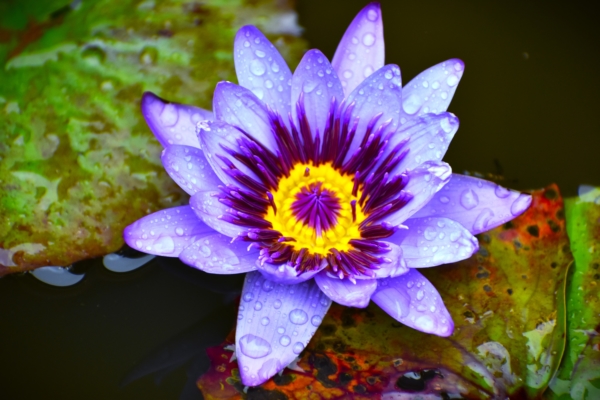
The blue lotus flower is known for its soothing properties and has caught the attention of many curious onlookers searching for a natural way to relax. It can be consumed as a tea, tincture, or, for those who want to get their mystical sun-fix, you can smoke it. Plus, with its association with the Sun God Ra in Egyptian culture, it’s like having a little piece of ancient history in your calming routine. The flower’s petals even follow the arc of the sun throughout the day, proving its sun-loving tendencies.
What is Blue Lotus Flower (Nymphaea caerulea)?

The Blue Lotus Flower, also known as Nymphaea caerulea, is a captivating aquatic plant that has been revered throughout history for its beauty and medicinal properties. It grows in the muddy shallow waters of the Nile River in Egypt and was a symbol of rebirth and spirituality in ancient Egyptian mythology. The flower has since spread to other parts of Africa and Asia, and its striking blue petals have attracted the attention of modern herbalists. Its root and petals are often used in traditional medicine to treat anxiety, insomnia, and inflammation, and it has been used in aromatherapy to induce relaxation and enhance mood. The flower is not only a stunning addition to any aquatic garden, but it also holds a rich cultural and medicinal significance worth exploring.
Blue lotus flower holds a significant place in ancient Egyptian culture owing to its use in both shamanistic rituals and healing practices. The plant was revered for its narcotic effects, which induced trance states of altered consciousness, and is frequently depicted in Egyptian art, artifacts, and hieroglyphics. From the 14th century B.C. onwards, blue lotus flower played a key role in ritual mourning and was an essential component in therapeutic and ceremonial plants utilized by the ancient Egyptians. The appearance of the plant in documented ceremonies and sacred iconography reinforces the Egyptians’ profound knowledge of its uses, marking it as a critical component of their religious and cultural heritage.
Read also: How 4 Indigenous Cultures Use Psychedelics
Blue Lotus Flower Active Compounds
Various active compounds within the plant have captured the interest of researchers and herbalists alike. Take apomorphine, a psychoactive alkaloid, for instance. Research has been conducted on its potential impact on mood, cognition, and addiction due to its interaction with vital neurotransmitters such as dopamine and serotonin. These neurotransmitters play a crucial role in regulating feelings of pleasure and mood. Another compound, nuciferine, is believed to be responsible for some of the plant’s calming and relaxing properties. The secret behind the flower’s potency lies in its flavonoid-rich composition. The blue lotus flower is abundant in flavonoids such as quercetin, kaempferol, myricetin, and flavonols, which have cancer-fighting properties. Additionally, flavonoids from blue lotus flowers have promising antioxidant activity. The alkaloid compound, nuciferine, present in the blue lotus flower is also a dopamine antagonist, which blocks dopamine receptor activity. The combined effect of these plant compounds makes the blue lotus flower a healing flower, perfect for those seeking natural remedies for their daily struggles.
Blue Lotus Flower Benefits
Throughout history, the blue lotus flower has been used for a variety of health issues as a therapeutic tool. Although some research suggests that it can help ease anxiety, stress, and insomnia, there have been no clinical trials to assess the effectiveness or safety of blue lotus for these conditions. It is crucial to consult with your doctor before taking blue lotus, especially if you have a pre-existing medical condition or are taking medication. There may be potential interactions between certain herbs and supplements and medication, which can cause side effects. It is important to be aware of these risks before using any supplements or herbs, including blue lotus flower.
Addiction
The flower has increasingly gained attention for its potential in treating addiction, particularly with its component nuciferine and its metabolite atherosperminine. This compound has been linked to dopamine receptors, giving it antipsychotic and treatment properties for those with alcohol and tobacco use disorder. Animal studies further reveal that nuciferine may have some behavioral effects such as anticonvulsant action and morphine analgesia. Despite these promising benefits, caution is still necessary as apomorphine, which is used in combination with blue lotus for addiction treatment, can potentially be addictive itself. While the blue lotus flower provides a potential solution to addiction, it is important to heed safety measures when administering high doses.
Parkinson’s Disease
Parkinson’s disease is a debilitating condition that causes tremors, muscle rigidity, and other symptoms that can adversely affect one’s quality of life. While some limited scientific data suggests that blue lotus flower may help alleviate these symptoms, there have been no clinical trials to confirm its safety or effectiveness. However, the use of apomorphine to alleviate spasticity in paralysis agitans patients dates back to 1935, and it has since become a valuable drug for antiparkinsonian treatment. This medication is available in Europe either as a pen injection or through continuous infusion and has demonstrated efficacy in treating advanced cases of Parkinson’s disease. Unfortunately, many patients worldwide still do not have access to this treatment, despite the positive impact it can have on their quality of life.
Relaxation
As discussed above, blue lotus has been a popular relaxation and anti-anxiety ingredient in traditional medicine across cultures for centuries with the general belief that some of its active compounds, such as apomorphine and nuciferine have relaxation enhancing properties. As a nervine, this herb supports balance in the central nervous system, helping to ease stress, anxiety, and insomnia. Its euphoric effects can also help decompress the mind and provide relief from tension. Additionally, blue lotus is believed to enhance sexual pleasure and function, making it a sought-after herb for those seeking a natural aphrodisiac. However, while the benefits of blue lotus are promising, scientific evidence is currently limited, and more research is needed to determine its safety and efficacy. Nonetheless, many people swear by its relaxing properties, and the flower continues to be a popular choice for those seeking a natural way to unwind and promote feelings of calmness.
Lucid Dreaming
Many people are fascinated by the idea of lucid dreaming because it allows them to have experiences they cannot have in waking life. Some people have turned to the blue lotus flower as a tool to induce this dream experience where the dreamer is aware they are dreaming. Many believe that by recognizing oneself in a dream, dreamers may have some control over how their dreams unfold. Lucid dreamers report being able to manipulate several factors within their dreams, such as flying, reliving memories, acting out fantasies, and more. There are many anecdotes claiming that the combination of euphoric and drowsy effects promotes vivid and lucid dream states. However, since no research on the topic actually exists, it is difficult to substantiate these claims.
Are There Any Side Effects From Consuming Blue Lotus?
While blue lotus may seem like a natural remedy for certain ailments, it’s important to tread with caution. The properties of this flower have the potential to become unwanted “side effects”. In fact, documented cases have shown patients in the ER with symptoms like confusion, anxiety, paranoia, slurred speech, chest pain, disorientation, and drowsiness from inhaling or consuming blue lotus flower. While most symptoms seem to resolve without treatment within 3-4 hours, they can be severe while they last. Those taking dopamine-related drugs, pregnant or breastfeeding women, and those with medical issues should avoid blue lotus. It’s also important to be wary of where you buy this herb as the supplement industry is highly unregulated. Blue lotus plants are endangered, so you may end up with a product that contains no blue lotus or is contaminated with toxins.
Blue Lotus Consumption Methods
There are a variety of ways to consume the blue lotus flower, from steeping in teas and smoking to making tinctures and infusing in oils. It is important to note that the potency of the flower can vary depending on the method of consumption and dosage, so it is recommended to start with a small amount and gradually increase as needed. Whether trying it for its potential health benefits or simply for its unique flavor, experimenting with different blue lotus consumption methods can be an exciting journey.
Blue Lotus Flower Tea
To make the tea, start by steeping the dried blue lotus flowers in hot water for 10-15 minutes. Once the tea has been infused, strain the flowers out and enjoy the fragrant and delicate flavor. Adding honey or lemon can enhance the taste of the tea, but it is equally satisfying on its own. With just a few simple steps, you can enjoy the tranquil effects of blue lotus flower tea anytime of the day.
Smoking Blue Lotus
If you’re interested in smoking blue lotus flower, there is a simple and straightforward method to follow. Start by grinding the dried flowers into a fine powder using a grinder or mortar and pestle. Then, fill your smoking device or rolling papers with the ground flower. Once ready, light the flower and inhale the smoke through the mouthpiece of the device or from the rolled paper. Remember to exhale the smoke and repeat as desired. However, it’s important to start with a small amount and gradually increase the amount as needed. Smoking large amounts of blue lotus could lead to side effects such as dizziness, nausea, and vomiting. Additionally, it’s important to be aware that smoking can harm your health and increase the risk of lung cancer and other respiratory problems.
Ticture
Tinctures are a popular way to take herbal remedies, and making your own is a great way to ensure the quality and potency of your tincture. To make a blue lotus flower tincture, you will need dried blue lotus flowers, alcohol (such as vodka or brandy), a glass jar with a tight-fitting lid, a strainer or cheesecloth, and a dark-colored glass dropper bottle. Mix a 5:1 ratio of alcohol to dried herb and allow the mixture to steep for several weeks. Simply fill the jar with enough alcohol to cover the flowers, seal it tightly, and shake it daily for 4-6 weeks. After that, strain the tincture and transfer it to a dropper bottle. To use, add a few drops to a glass of water or directly under your tongue. Remember to start with a low dose and follow the dosing instructions on the label. With proper use, blue lotus tincture may offer a range of potential benefits. This tincture can be used by adding a few drops to a glass of water or taking it directly under your tongue.
Disclaimer: Psychedelic Spotlight does not condone the use of illegal substances. The purpose of this article is for educational and harm reduction purposes only. If you suffer from a medical or mental condition, please consult with your doctor before taking any substance.





